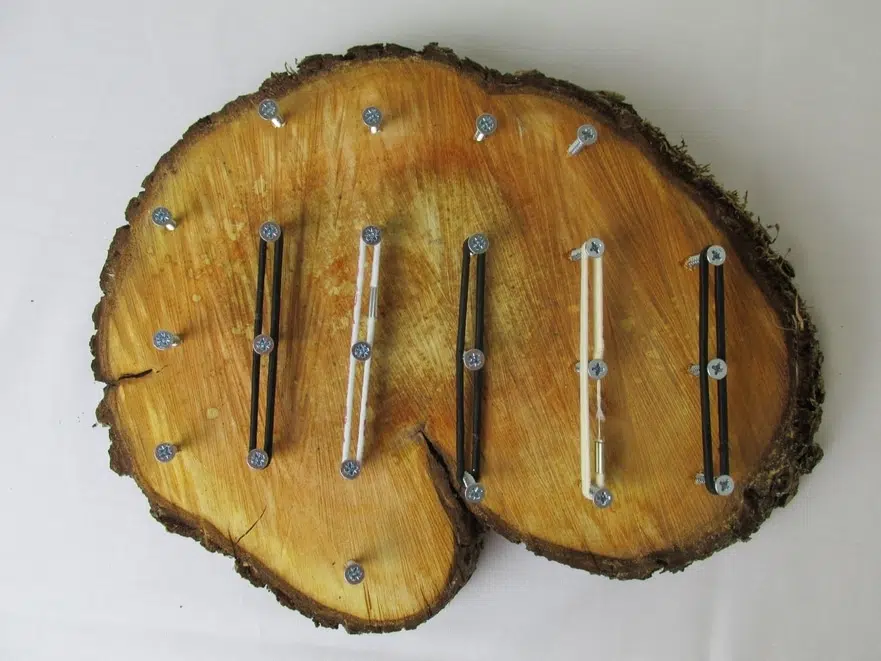Many children line up toys and objects as part of their play, and sometimes parents or educators are concerned that this is a sign of autism spectrum disorder.
Is lining up toys and other things a sign of autism?
Taken in isolation, lining up toys in play is not an indicator of autism. It is a highly common play behavior, known as a positioning schema. A child demonstrating this, but few other common autistic signs is highly unlikely to have autism.
A positional schema means a child is interested in order and sequencing. A huge number of typically developing children demonstrate this kind of behavior.
In this post, I will look at what a schema is, how a positional schema works, and the kinds of things you might observe from one.
I’ll also look at the most common early signs of autism to look for in children, so you can be assured of what to observe if you are still concerned that a child has autistic spectrum disorder.

Is Putting Things In A Line Ever A Sign Of Autism
It is true that putting objects in a line is one of about 30 commonly accepted signs of autism.
However, singled out by itself, it is almost certainly not an autistic issue.
Autistic children will show multiple signs of autism spectrum disorder, not just one.
For the vast majority of children, putting things in a line is a sign of a positional schema. Schemas are behavioral patterns that almost all children demonstrate and are nothing to be concerned about. They are just part of the way children learn.

What Is A Schema?
A schema is a concept that is used in child development psychology. Schemas have been understood for at least the last one hundred years.
The basic idea of schemas is that children create models of reality in their heads. They then test these models out on the world around them.
A well-known schema is a transporting schema. This basically means that children are interested in moving objects around a space, for example in their pockets, in bags, or in containers like buckets.
You’ve probably seen this one yourself!
Another really common one is a trajectory schema. This is an interest in making objects move and often manifests itself in throwing objects, pushing, spinning, or pulling.
Schemas are in no way linked to autism spectrum disorders. The majority of children demonstrate at least one schema in their play, and many demonstrate several simultaneously.
Positioning Schemas – Lining Up Toys and Other Things
So let’s move on to a positioning schema now.
This really is a common schema and one that teachers and educators see on a daily basis multiple times as children play.
With a positioning schema, children have developed a model in their heads around order and sequencing. They are testing this model on reality in their play.
These children enjoy placing objects in alignment. They are learning about order, sequence, and symmetry.
They often have a favorite toy, such as cars or trains, that they put in a line repeatedly.
They will repeat patterns of objects on top of one another, and alongside each other as well.
You can find my full description of what a positioning schema is in this post, alongside multiple ways of how to support it.
What You Might Observe
Common behaviors to witness in a typically developing child that has a positioning schema include:
- Lining up toys like cars or trains in a line
- Lining up animals in a toy farm
- Put loose parts such as stones, shells, or sticks in a line either indoors or outdoors
- Sitting toys such as teddy bears in a line
How To Support Putting Toys In A Line
A positioning schema is in no way a negative thing.
Quite the opposite – it is a positive force and one that should be supported.
Supporting any schema has many benefits such as:
- Supporting a schema deepens the level of children’s play
- You are working alongside children’s interests, and so they have a greater level of involvement
- Schemas show how children think and how they view the world
- Supporting schemas can help children learn at an accelerated rate
A positioning schema (putting things in a line), is also one of the safest and least intrusive schemas.
Some schemas have safety issues attached, such as a trajectory schema. If children are interested in throwing all objects they come across, then some others are at risk of being hurt by flying items.
Not so with a positioning schema! It is safe and doesn’t negatively affect others.
Also, children are learning about how to order and sequence objects in the world, both of which are crucial skills to learn in life.
Activities To Support A Postioning Schema
It is always best to work with schemas and to support them. To support a positioning schema, you can try some of the following:
- Create jewelry by threading objects like beads or pasta tubes onto thread or string.
- Playing with small loose parts (read some fantastic loose parts ideas in my article here)
- Placing rubber bands or hair bobbles on geoboards (more info on how to do that here)
- Observing reflections in water, and reflections in mirrors
- Playing with construction toys on large shatter-proof safety mirrors on the floor
- Counting and sorting objects
- Threading leaves onto a string
- Creating paper chains or paper dolls
- Using ‘mirror books’. These are simply two safety mirrors taped together, and then stood up like an open book. Children place all kinds of small objects inside the mirror books, and examine the reflections. Here is a picture of one in action:

What Are The Main Signs Of Autism Then?
Putting objects in a line is, admittedly, one of about thirty indicators of autism. But it is certainly nowhere near being one of the main ones.
According to medicinenet.com (Source) the main three signs of autism are:
- Delayed milestones.
- A socially awkward child.
- The child who has trouble with verbal and nonverbal communication.
Let’s take a deeper dive into what this could look like in reality.
The Main Traits Of Autism In Children
Delayed Milestones
Some of the most common ones that you will observe include:
- Autistic children will usually have delayed language skills. For example, they may not respond to their name after the age of one.
- Delayed movement skills. For example, children with autism often have delayed development in fine motor skills
- Delayed cognitive or learning skills, often demonstrated through a lack of speech or understanding
A Socially Awkward Child
Many autistic children lack social skills:
- Have a hard time making eye contact, and do not like looking at or interacting with others
- Often autistic children demonstrate few emotional facial expressions, such as sad, happy, surprised or angry.
- Don’t get involved in pretend play or imaginary play
- Don’t interact with other children or adults
Issues With Verbal And Nonverbal Communication
- Don’t respond in any way when others are distressed or upset
- Take little interest in what others around them are doing
- Delayed language development in relation to their peers
- Don’t pick up emotional cues from others that they are happy, sad or angry
An excellent article to read if you’re looking for the full list of autistic traits in children is this one on the cdc.gov site – https://www.cdc.gov/ncbddd/autism/signs.html
Repetitive Behaviors in Autistic Children
Positioning objects is a type of repetitive behavior, so let’s just have a look at some other repeating behaviors that you will regularly see in autistic children at a very young age.
Hopefully, this will help you see how lining up toys is only a very small part of autistic behaviors.
These repetitive behaviors in autistic children include:
- Echolalia – which is repeating words or phrases over and over again
- They can get distressed by changes in routines or environment, however minor
- They have strong and obsessive interests
- Stimming – which can manifest often as hand flapping, spinning, or rocking back and forth
- Plays with the same objects and in the same way repeatedly
- Often children are interested in just one part of a toy, for example, the steering wheel of a car
- Line up objects or toys
Summing Up
As you can see, lining up toys and other objects is a perfectly normal behavior that almost always is not a symptom of underlying autism.
Only if it is observed alongside many other autistic factors, should it be linked to autism at all.
Teachers and educators witness children lining up toys in their play on a daily basis.
If you are still concerned that a child in your care may have autism, always the best advice is to seek advice from a medical professional.
